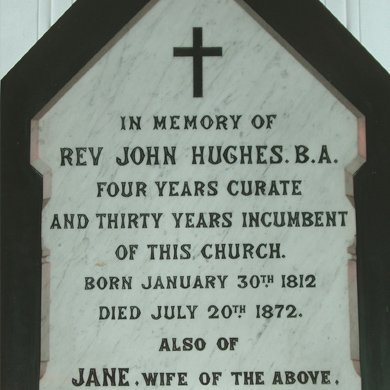John Hughes
John Hughes served the church from its last years as a chapel of ease, through renaming in 1846 and finally achieving parish status in 1868. He was married here, his children were born here and he and his wife, Jane, died here. He was part of the centuries old tradition in this church of a preaching ministry, which can be traced back to the reign of Elizabeth I. In 1857 he preached “before the working men of Congleton” on the text from Joshua, “Choose you this day whom ye will serve” and chose as an illustration the parable Jesus told of a wealthy farmer. The farmer`s goods so increased he pulled down his barns and built bigger ones, but in the night the farmer died. Hughes said “This parable is applicable to a rich cotton spinner, or a wealthy silk master, or a prosperous shopkeeper.” Hughes had cotton spinners, silkmen, shopkeepers, craftsmen, and landowners in his congregation. Indeed in 1840 both the Chapelwardens were mill owners. The full sermon was printed in the local paper at the “Mercury “ Office, Congleton, by R Carson.
The sketch of 1847 by Greenwood is a snapshot of the interior just over a hundred years after the chapel was rebuilt and seven years after the galleries were completed. However, it is probably more interesting as the record of an event. It shows a baptism. On June 18th 1847 John Hughes baptised the baby son of Thomas Hughes, his brother. Further evidence from the Register shows that the boy was called John Sumner Hughes. A note in John Hughes handwriting in the Register records that also on the 18th June 1847 the Lord Bishop of Chester conducted a confirmation service in the church. The bishop`s name was John Bird Sumner. Is he the “third man” in the sketch? Sumner was a noted Evangelical and moved from Chester to become Archbishop of Canterbury.

Graveyard
John Hughes and his family are buried in the churchyard. The inscription on the top of the stone reads: “Members of the congregation, school, children and friends placed this stone over one who for 34 years by his life and teaching was an example of Christian charity.”


